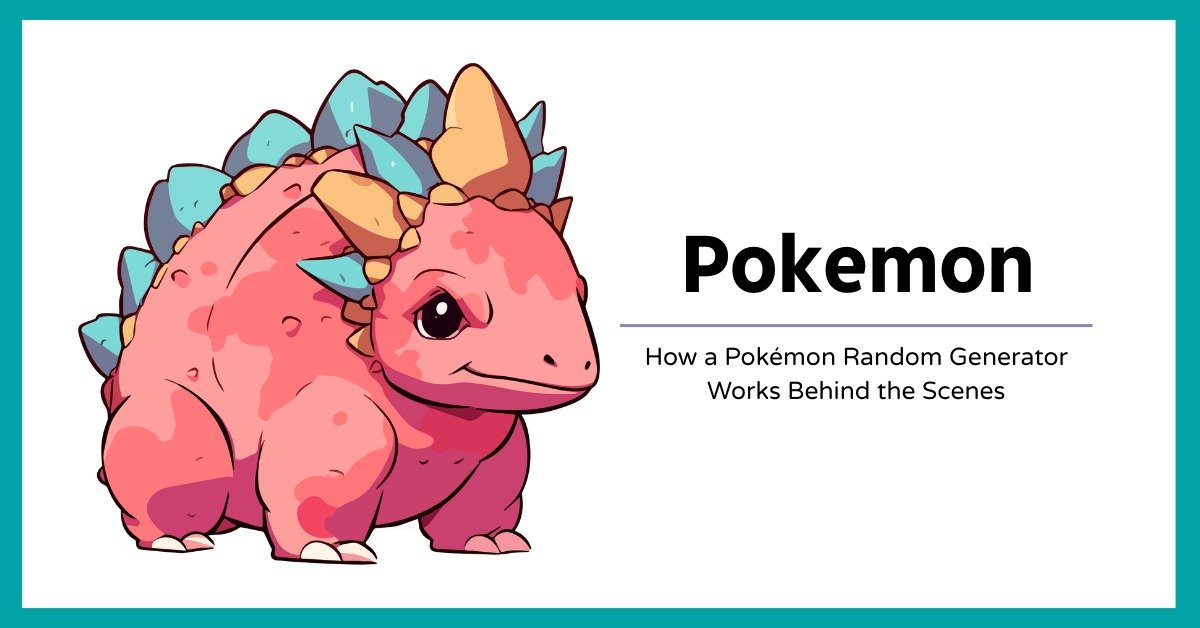The market gains new AI tools, random generator tools, VPNs, and AI models every morning. I’d like to introduce a new tool that allows you to create your beloved Pokémon. What appears to be pure magic on the surface is actually the result of clever algorithms and web technologies working behind the scenes. From gaming platforms to data science applications, digital randomness powers countless experiences we interact with every day.
One fun example of this is the Pokémon Random Generator, a tool designed to produce random Pokémon selections for fans and developers alike instantly. While it may seem simple, the technology underlying it involves random number generation, data handling, and user interface optimization to make each click seamless and unpredictable.
2. What Is a Pokémon Random Generator?
A Pokémon random generator is an online tool that instantly produces random Pokémon names, images, or stats with a single click. Fans often use it for fun team-building challenges, creative fan art ideas, gameplay variations, or simply to test their Pokémon knowledge. What feels like a spontaneous selection is actually driven by structured data and precise algorithms that ensure fair randomness.
Modern versions, like the Pokémon Random Generator, combine speed, accuracy, and a clean user interface to make the experience enjoyable and effortless. With just one tap, users get a truly random Pokémon result, proof that technology and entertainment can blend perfectly when powered by smart coding and thoughtful design.
3. The Science of Randomness in Code (165 words)
Behind every Pokémon random generator lies the fascinating science of random number generation (RNG). In other words, RNG is a process that allows a computer to produce numbers that cannot be easily predicted in advance. These unpredictable numbers are used to create random outcomes, such as deciding which Pokémon appears when you click “Generate.”
Most online tools rely on pseudo-random number generators (PRNGs) — algorithms that create sequences of numbers that appear random but are actually derived from mathematical formulas. For Pokémon generators in JavaScript, the most common methods include Math.random() for general selection and crypto.getRandomValues() when cryptographic security is required, both of which help avoid predictable patterns that could undermine a sense of fairness.
When you press the generate button, the system assigns a random number between 1 and 1010 (the total number of Pokémon). That number corresponds to a Pokémon’s ID in the dataset, directly affecting which Pokémon appears on screen. This process, rooted in both mathematics and code, combines precision and unpredictability, ensuring every generation feels fresh, fair, and completely random to the user.
4. Filtering & Customization
A great Pokémon random generator doesn’t just pick random results — it lets users actively shape the randomness they experience. By applying filters such as generation, Pokémon type, or legendary status, users customize the outcome, creating a greater sense of control without losing the excitement of not knowing what will appear.
Here’s how it works behind the scenes:
- The tool retrieves a filtered dataset based on the user’s selected options.
- It then runs the RNG process only within that subset.
This balance gives users control while maintaining the fun of unpredictability. For instance, if you choose to generate only Water-type Pokémon from Generations I–IV, or limit the results to legendaries, the generator adapts, still providing random results within your selection. This ensures the experience remains both customized and surprising.
This system is what makes tools like the Pokémon Random Generator both interactive and flexible — combining personalization and true randomness to keep every experience unique and engaging, directly connecting technical design with user enjoyment.
5. Data Handling & Performance
Behind the fun interface of a Pokémon random generator, there is efficient data management. Often, these tools use structured databases in JSON format or access public online sources, known as APIs (for example, PokéAPI). These databases store useful details like names, types, and images of Pokémon. Instead of loading this data every time, the tool utilizes caching, temporarily storing important data in the computer’s memory. This makes sure the results appear instantly for users.
Caching and intelligent data handling prevent unnecessary API calls, reduce server load, and enable results to appear in milliseconds. Efficient algorithms also eliminate duplicate results when users request multiple Pokémon at once.
Tools like MyRandomGenerator’s Pokémon generator are optimized for speed and simplicity, ensuring smooth, lag-free results on any device. Smart data engineering is as crucial as creative design in delivering great modern web tools.

6. User Interface & Experience
Even the most sophisticated algorithm requires an engaging design to succeed. A good Pokémon random generator features a clean, responsive, and intuitive user interface. Simple buttons, drop-down menus, and instant visual feedback make it enjoyable for everyone — from casual fans to tech enthusiasts.
When a user clicks “Generate Pokémon,” the name, image, and type appear immediately without page reloads. This smooth experience keeps engagement high and encourages users to explore more filters and options.
Accessibility is also key — responsive layouts ensure the tool works flawlessly across devices, from phones to tablets. Ultimately, great UX transforms a technical algorithm into a fun, shareable experience for fans worldwide.
7. Applications Beyond Pokémon
While Pokémon random generators are for fun, the same randomization technology powers many digital systems. Streaming platforms shuffle playlists, marketers run A/B tests, and games use random item drops. Random art and name generators spark creativity with similar logic.
These examples show how randomness shapes digital experiences in subtle yet powerful ways. Developers and AI users test logic, performance, and engagement with random generators, making sure systems act fairly and creatively. The Pokémon random generator is a lighter version—a reminder that every “random” online moment relies on smart programming.
8. How to Build a Simple Pokémon Random Generator
Creating a Pokémon random generator is straightforward. Here’s a simple guide to begin:
- Prepare a dataset — Collect Pokémon IDs (unique numbers for each Pokémon), names, types (such as Water or Fire), and images. Store this information in a format like a JSON file or accessible through an application programming interface (API), which is a tool for interacting with the data.
- Add randomness — Use JavaScript’s Math.random() function (a tool to generate unpredictable numbers) to randomly select a Pokémon ID from the dataset.
- Display the result — Dynamically (instantly, without reloading the page) show the Pokémon’s name and image on the screen using HTML (web page structure code) and CSS (styling code for appearance).
- Add filters — Let users choose specific features, such as Pokémon generation (the era or set a Pokémon was introduced), type (like Grass, Water, or Fire), or rarity to customize their results.
- Refine the UX — Improve the user experience (UX) by including buttons for easy interaction, instant feedback (immediate responses to user actions), and smooth animations that enhance the way information appears on screen.
For instance, the MyRandomGenerator Pokémon tool uses this approach with sleek design, structured data, and responsive speed. Whether you are a new developer or a dedicated hobbyist, building a generator like this is an enjoyable way to learn how randomness, logic, and interface work together online.
9. Future of Online Random Tools (110 words)
The direction of random generation is rapidly changing due to AI and machine learning. New AI-powered randomizers now generate fresh content, such as unique Pokémon designs, novel character names, or hybrid creatures.
The next generation of random tools will merge unpredictability with personalization, offering users outcomes matched to their interests while maintaining surprise. Improved algorithms, offline use, and real-time data will make them more effective.
From gaming to education to creativity apps, random tools will keep blurring the line between chance and design—keeping users inspired and entertained.
10. Conclusion
Pokémon random generators show how randomness and technology meet. Every “Generate” click blends algorithms, data, and design to make digital fun feel spontaneous.
These tools remind us that small web creations reflect big ideas—logic, code precision, and design working together. Whether you’re a fan, coder, or curious, try the Pokémon Random Generator and watch the magic unfold. Sometimes, a little randomness sparks creativity and joy.
